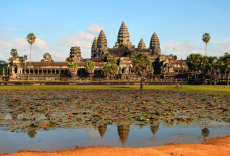
Angkor Wat is a temple in Cambodia and is the largest religious monument in the world. It was built in the 12th century by the Khmer king Suryavarman II as a state temple to the Hindu God Vishnu. Later it became a Buddhist temple, and remained so throughout its history. Today, Angkor Wat is one of Cambodia’s main tourist attractions and has become a symbol for the country.
The temple is made up of three large rectangular levels which rise up to a central tower symbolising Mount Meru, the spiritual home of the gods in Hindu and Buddhist philosophy. There are four other towers at the corners of each of the galleries, and the set of five towers together represent the five peaks of the mountain. Angkor Wat is a huge complex, taking up more space than the whole of modern day Paris. It has an outside wall 1,024 by 802 metres long and is surrounded by a moat 190 metres wide. Originally these enclosed both the temple, and the city and the royal residences. However, these structures were built of wood which hasn’t survived over the centuries. The whole monument is made out of nearly 10 million sandstone blocks, and is made with more stone than all of the Egyptian pyramids combined.
Almost every surface in Angkor Wat is covered with intricate stone carvings known as bas-relief friezes. These carvings illustrate episodes from the Hindu epics the Ramayana and the Mahabharata. The most famous carving is in the temple’s east gallery, and shows the Churning of the Sea of Milk. This is a story about how asuras and devas, angels and demons, churned the ocean to make Amrita, the nectar of immortal life. The southern gallery features the only historical scene, a royal procession of king Suryavarman II.
Suryavarman II was one of the greatest kings of the Khmer Empire. The Empire stretched over most of mainland southeast Asia, but in the years before Suryavarman II’s reign it had been torn apart by war. Suryavarman reunited the empire, and built many beautiful temples including Angkor Wat, which during its peak was the largest pre-industrial urban centre in the world.
Towards the end of the 12th century Angkor Wat was transformed into a Buddhist temple. Hundreds of years later it was still in use; inscriptions show that Buddhist Japanese pilgrims were visiting in the 17th century. By the 20th century the temple needed restoration, although its large moat had protected it from being completely overgrown by the jungle. Restoration efforts were interrupted by the Civil War in the 1960s and 70s, and the Khmer Rouge seizing control of the country in the 1970s and 80s. Bullet holes from a shoot-out between Khmer Rouge and American forces can be seen in ones of the friezes at the temple. More damage occurred after the wars, when art thieves from Thailand stole heads off many of the statues.
Angkor Wat is now a UNESCO World Heritage site, and a lot of effort and money goes into its conservation. It is a powerful symbol of Cambodia, and has been represented on the country’s flag since 1863.
Image from Wikipedia.

0 Comment:
Be the first one to comment on this article.